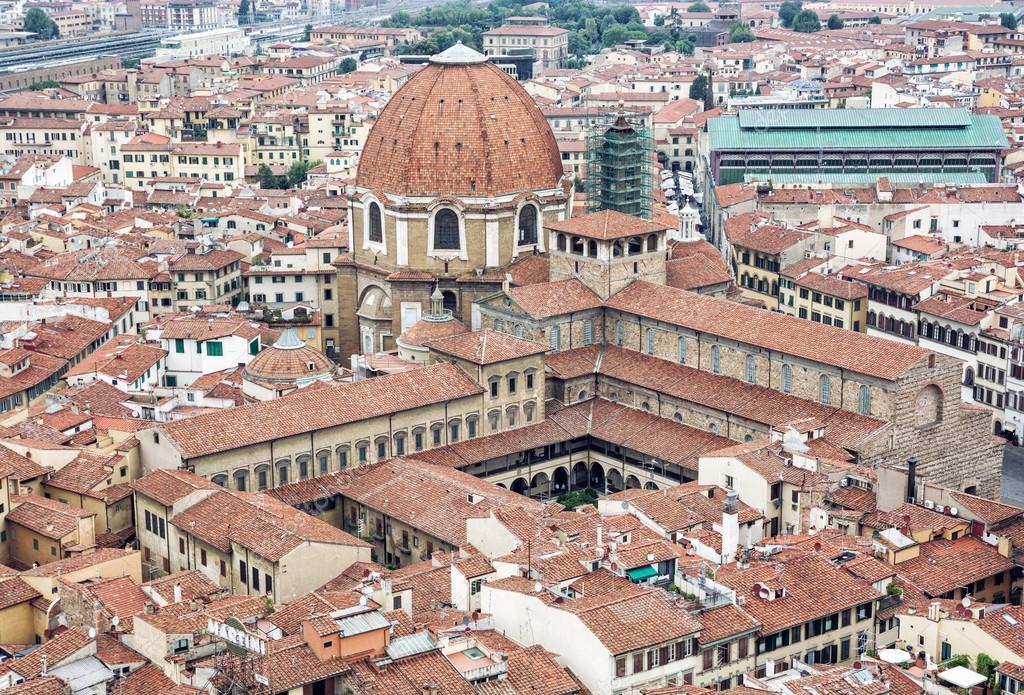 Florence – Saint Lawrence
Florence – Saint Lawrence
Established in the 4th century. Saint Lawrence (8.00-12.00 i 15.30-19.00) it is considered the oldest church in Florence and served as the city's cathedral for almost three hundred years. As it was the Medici parish church, enjoyed the patronage of this family: w 1425 r. Giovanni Bicci de 'Medici commissioned Brunelleschi to rebuild San Lorenzo, a move that marked the beginning of the family's long relationship with the building. Although Michelangelo was tired of the design of the facade of San Lorenzo, bare brick has never been covered and is rough, the wrong prelude to Brunelleschi's powerful simplicity of interior, which is one of the earliest Renaissance designs for religious buildings.
Inside, two images stand out - the Wedding of the Virgin Mary by Ross Fiorentino (the second chapel on the right) and the Annunciation of Filippo Lippi (in the chapel on the west side of the left transept). More striking, however, are the two bronze pulpits by Donatello. They are densely covered with disturbing reliefs, showing mainly scenes before and after the Crucifixion, and are the artist's last works, completed by his students. Nearby, at the foot of the altar steps, a large shield of multi-colored marble is the tombstone of Cosimo the Elder, the main patron of the artist.
More works by Donatello (who is buried in the chapel with a painting by Lippi) they decorate the neighboring Sagrestia Vecchia (the old sacristy). Most of the decorative work here is by Donatello - two bronze doors, great reliefs with Saints Cosmas and Damian and Saint. Wawrzyniec and Stefan and eight terracotta tondas. The milky marble plaque in the center of the room is the tomb of Cosimo the Elder's parents, Giovanniego Bicci de’Medici and Piccardy Bueri.
LAURENZIANA HIBLIOTECA
A door at the end of the left aisle of San Lorenzo leads to the courtyard and the stairs of the Biblioteca Laurenziana (pn.-sb. 9.00-13.00; Free entrance), a key example of Mannerist architecture. Willing to create a suitably sublime headquarters for the valuable manuscripts collected by Cosimo the Elder and Lawrence the Magnificent, Pope Clement VII (nephew of Lawrence) w 1524 r. commissioned Michelangelo
design of a new Medici library.
The artist's striking idea is the vestibule of the building, room almost completely filled with stairs, reminiscent of a solidified lava flow.
This consciously eccentric space leads to a calm and architecturally correct reading room, from which you cannot see the illogically arranged columns and pillars of the vestibule. Annual exhibitions, which are held here, draw their exhibits from the Medici collections, covering manuscripts as varied as a copy of Virgil's works from the 5th century. and the treatise on architecture by Leonardo da Vinci.
CHAPEL OF MEDICES
Among the buildings of San Lorenzo is Michelangelo's famous Sagrestia Nuova, which is part of the Medici Chapel (wt.-sb. 9.00-14.00, nd. 9.00-13.00; 4500 L) and which is entered from Piazza Madonna degli Aldobrandini. The larger of the two chapels is the Cappella dei Principi (The Princes' Chapel), large hall lined with marble slabs, built as the mausoleum of Cosimo I and his ancestors. The tastefully decorated chapel was the most expensive construction project financed by this family and it embodies a mentality, according to which the grandeur of the building is directly proportional to the cost.
New sacristy (New Sacristy), one of the earliest mannerist buildings, was started in 1520 r. and was to be both a tribute to the Old Sacristy (Old Sacristy) Brunelleschiego, as well as its opposite. Architecture connoisseurs melt in admiration for the intricate carnets over recesses and other such decorations, but amateurs will focus primarily on the Medici tombs, carved by Michelangelo in the years 1524-1533. On the left side is the tomb of Lawrence, Prince Urbino, grandson of Wawrzyniec the Great; He is shown as a man of thought and his sarcophagus shows the figures of Dawn and Dusk, times of the day, whose ambiguity pleases contemplative minds. Opposite is the tomb of the youngest son, Lawrence the Magnificent, Giuliana, the Duke of Nemours; the character of this man of action is represented as Day and Night. The characters of both princes are idealized, Lawrence and Giuliano were people deprived of personality and after their early death no one mourned them. Their images were to look at the equally lofty tombstones of Lawrence the Magnificent and his brother Giuliano; unfortunately, Michelangelo did not complete the entire project; he only created a cheerful Madonna and Child, last image of Madonna, which he carved.
Medici-Riccardi Palace
On the edge of the square, in front of San Lorenzo, stoi Palazzo Medici-Riccardi (pn., wt. and Thu. 9.00-12.45 i 15.00-16.45, nd. 9.00-12.00; Free entrance), built for Cosimo the Elder by Michelozzo in the 1540s. This monolithic, the lavishly rusticated palace was the prototype of such houses as Palazzo Pitti and Palazzo Strozzi, but in the 17th century. was completely rebuilt by new owners, ród Riccardi.
Only the chapel on the top has been preserved from Michelozzo's original design; the interior is covered with a colorful narrative fresco of the Cortege of the Three Kings, painted around 1460 r. przez Benozza Gozzoli. The procession is basically a pretext to present dozens of exotic costumes and portraits of members of the Medici household - the main cavalcade is led by the romanticized Lawrence the Magnificent, and his father walks slowly behind him, Piero the Gouty. The artist himself is in the crowd behind the dawn, and the painter's name is inscribed in gold on his red beret. Another staircase leads from the courtyard to the Sala di Luca Giordano, gilded, a gallery covered with mirrors, where the Madonna and Child by Filippo Lippi and the plafond fresco are noteworthy Apotheosis of the Medici by Luka Giordano, works, from which one can only deduce, that Giordano felt no shame.